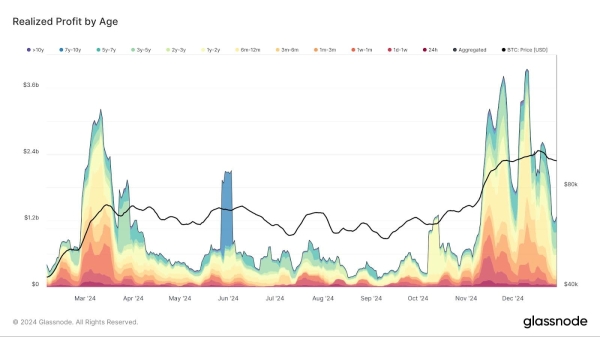Bitcoin (BTC) Price Slumps to $92,000 as Long-Term Holders Keep Taking Profit
Macroeconomic concerns and rampant profit-taking are weighing on the crypto market as the year comes to an end.

What to know:
- Bitcoin fell to the lowest price since the day it broke above $100,000.
- The slump is partially due to elevated profit-taking.
- Macroeconomic considerations are also weighing on the crypto market.
Crypto prices are experiencing a rocky Monday due to poor U.S. macroeconomic data and rampant profit-taking.
Bitcoin (BTC) has dropped 1.8% in the past 24 hours to $91,800, a price not seen since Dec. 5, the day it broke through $100,000 for the first time. The largest cryptocurrency has fallen more than 14% from its Dec. 17 record of $108,278.
Ether (ETH) has lost less, falling 0.7% to $3,320, though it’s now 17% below its December highs, and still has not surpassed the record $4,820 it hit in 2021. Solana (SOL) is also proving a little stronger than bitcoin, with the SOL/BTC ratio up 0.35% today.
The CoinDesk 20 — an index of the top 20 cryptocurrencies by market capitalization, excluding stablecoins, memecoins and exchange coins — is also in the red, sliding 3.74%. Ripple (XRP) and Stellar (XRM) have taken the biggest hits, down 6% and 6.3% respectively, while the most resilient coin besides ether has been litecoin (LTC), which is 1.9% lower.
Stocks of crypto-related companies also took a hit. MicroStrategy (MSTR) and Coinbase (COIN) fell 7% and 5.3%, respectively and major bitcoin mining firms like MARA Holdings (MARA) and Riot Platforms (RIOT) have dropped more than 7%.
The selling pressure is partially caused by investors cashing out after bitcoin shot up more than 117% this year. Profit-taking currently exceeds $1.2 billion on a seven-day moving average, and while that is significantly less than the Dec. 11 peak of $4.0 billion, it’s still much more than usual. Additionally, the lion's share of profits is being taken by investors who have held bitcoin for many years.

Macroeconomics are also weighing on the market, with the U.S. Chicago PMI — which measures the performance of the manufacturing and non-manufacturing sector in the Chicago area — flashing its lowest reading since May, suggesting an economic slowdown is underway.
Uncertainty around the Federal Reserve’s interest-rate policy going into 2025 isn’t helping, since the U.S. central bank has signaled it will pause rate cuts until at least March. The inauguration of President-elect Donald Trump, slated for Jan. 20, may also be playing a role. The S&P 500, Nasdaq, and Dow Jones are down more than 1%.
"The market exceeded expectations in 2024, but signs of exhaustion signaled the need for consolidation," Joe Carlasare, partner at Amundsen Davis, told CoinDesk. "Looking ahead to 2025, I’m optimistic but expect the path to diverge from consensus, as markets often do. Bitcoin’s adoption continues to grow, and I anticipate it will generally move in line with traditional markets. If the U.S. avoids a significant growth slowdown, bitcoin should perform well, though the ride may be bumpier than in 2024."



